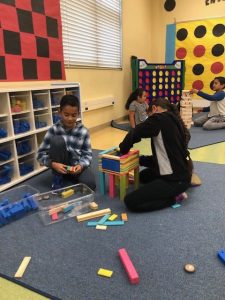A Creative Approach to Student Health and Wellness
Pacific Boulevard School
Huntington Park, California
 When it comes to getting kids to eat well and be more active, Pacific Boulevard School in Huntington Park, California faces layers of challenges. Not only is the Pre-K–5 school classified as a Title I, meaning that more than 98 percent of its student population comes from low socioeconomic households, it’s the only school in the Los Angeles Unified School District to serve students with moderate to severe disabilities—autism, cerebral palsy, genetic disorders and other medical conditions, in most cases two or more—while still serving a general student population.
When it comes to getting kids to eat well and be more active, Pacific Boulevard School in Huntington Park, California faces layers of challenges. Not only is the Pre-K–5 school classified as a Title I, meaning that more than 98 percent of its student population comes from low socioeconomic households, it’s the only school in the Los Angeles Unified School District to serve students with moderate to severe disabilities—autism, cerebral palsy, genetic disorders and other medical conditions, in most cases two or more—while still serving a general student population.
Those factors made Pacific Boulevard a prime candidate for a $25,000 “BE Time” Game On Grant from Action for Healthy Kids, generously sponsored by Materne GoGo squeeZ, for the 2018-2019 school year. BE Time, a concept championed by GoGo squeeZ, emphasizes the importance of providing kids with the unstructured, quality time they need to nourish their imaginations, creativity, bodies and relationships—time to just be kids.
Pacific Boulevard’s health and wellness team, made up of administrators, school health professionals, teachers and parents, made the concept its own by introducing OTTER Time (Our Time to Enjoy Relaxing) and focusing on increasing opportunities for physical activity and play for all students, regardless of ability. As part of the initiative, the team began allowing kids to play basketball and participate in other activities on school grounds before the bell rang, and even formed a before-school walking club to get students moving for 15 minutes each morning. It also encouraged classroom teachers to implement brain breaks throughout the day, whether they involved physical activity—such as getting students out of their seats to watch a GoNoodle movement video or do a quick exercise at their desks to increase their blood flow and oxygen—or a quieter activity like drawing, coloring, or listening to music.
Additionally, the team asked playground staff to encourage students to walk, run or play games during recess and lunchtime instead of standing or sitting around. Using grant funds, the school purchased new playground equipment for PE classes and planned monthly physical fitness activities including a walkathon, dance-a-thon and jump-a-thon. To ensure students were getting at least 100 minutes of physical education a week, each teacher started keeping a monthly log and submitting it to administrators for review.
The highlight of the grant project and an important part of Pacific Boulevard’s OTTER Time initiative was the creation of a Creative Expression Lab that students could visit for 30 minutes once a week to engage in leisure activities such as drawing, painting, playing board games, and reading. Inspired by the sensory rooms dedicated to special education students, the two once-empty rooms were completely transformed and offer both quiet and loud spaces for kids to choose the types of activities they want to engage in each visit. To let kids know that their parents support the idea of unstructured play, the school recruited parents to take an active role in designing and decorating the room, making it into a cozy place for their children and the rest of the school to relax and de-stress from schoolwork.
“The kids love going to the CEL room and look forward to it all week,” said Souad Gallegos, 2nd grade general education teacher.
What’s more, while the school’s general education students learn through weekly inclusion activities to be empathetic toward their peers with disabilities, the CEL Room has done even more to foster kindness and conflict resolution.
“Student-peer relations have improved,” said Seon Lee, 3rd grade general education teacher. “Students cooperate, collaborate and resolve conflicts in a positive manner.”
With Pacific Boulevard increasing BE Time by 15 minutes per day since the beginning of the school year, Tiffany Martinez, special education teacher and the primary grant contact, reported other improvements as well: increased student enthusiasm and willingness to engage in free time; increased cooperation and teamwork; increased imagination and discovery; improved behavior and focus in the classroom; improved physical fitness and healthy eating behaviors; and improved academic performance, among others.
It goes to show that when you give kids the opportunity to just BE, the sky is the limit!
Categories: Elementary School, GoGo squeeZ, School Grants, California